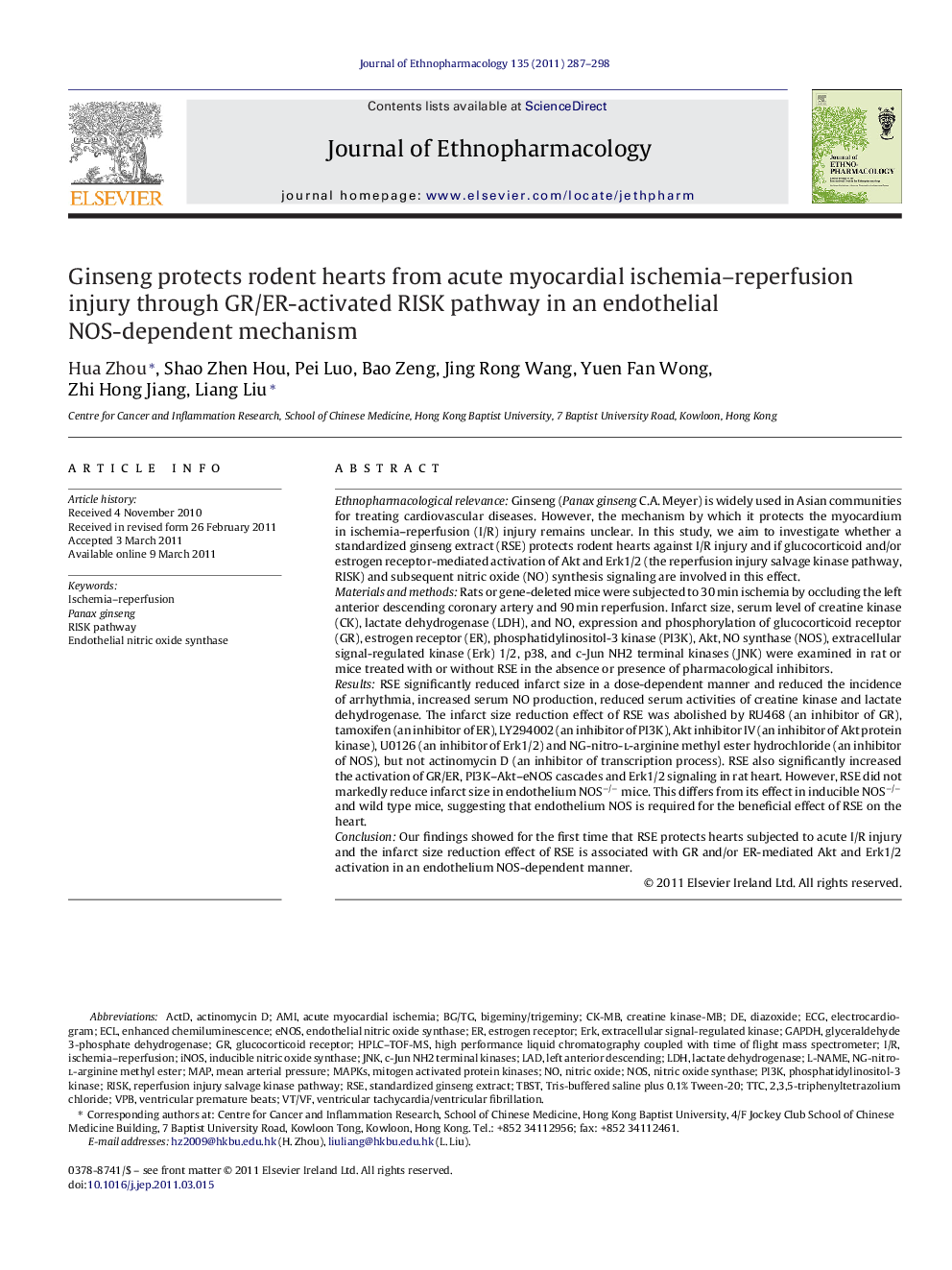| کد مقاله | کد نشریه | سال انتشار | مقاله انگلیسی | نسخه تمام متن |
|---|---|---|---|---|
| 5839735 | 1123999 | 2011 | 12 صفحه PDF | دانلود رایگان |

Ethnopharmacological relevanceGinseng (Panax ginseng C.A. Meyer) is widely used in Asian communities for treating cardiovascular diseases. However, the mechanism by which it protects the myocardium in ischemia-reperfusion (I/R) injury remains unclear. In this study, we aim to investigate whether a standardized ginseng extract (RSE) protects rodent hearts against I/R injury and if glucocorticoid and/or estrogen receptor-mediated activation of Akt and Erk1/2 (the reperfusion injury salvage kinase pathway, RISK) and subsequent nitric oxide (NO) synthesis signaling are involved in this effect.Materials and methodsRats or gene-deleted mice were subjected to 30Â min ischemia by occluding the left anterior descending coronary artery and 90Â min reperfusion. Infarct size, serum level of creatine kinase (CK), lactate dehydrogenase (LDH), and NO, expression and phosphorylation of glucocorticoid receptor (GR), estrogen receptor (ER), phosphatidylinositol-3 kinase (PI3K), Akt, NO synthase (NOS), extracellular signal-regulated kinase (Erk) 1/2, p38, and c-Jun NH2 terminal kinases (JNK) were examined in rat or mice treated with or without RSE in the absence or presence of pharmacological inhibitors.ResultsRSE significantly reduced infarct size in a dose-dependent manner and reduced the incidence of arrhythmia, increased serum NO production, reduced serum activities of creatine kinase and lactate dehydrogenase. The infarct size reduction effect of RSE was abolished by RU468 (an inhibitor of GR), tamoxifen (an inhibitor of ER), LY294002 (an inhibitor of PI3K), Akt inhibitor IV (an inhibitor of Akt protein kinase), U0126 (an inhibitor of Erk1/2) and NG-nitro-l-arginine methyl ester hydrochloride (an inhibitor of NOS), but not actinomycin D (an inhibitor of transcription process). RSE also significantly increased the activation of GR/ER, PI3K-Akt-eNOS cascades and Erk1/2 signaling in rat heart. However, RSE did not markedly reduce infarct size in endothelium NOSâ/â mice. This differs from its effect in inducible NOSâ/â and wild type mice, suggesting that endothelium NOS is required for the beneficial effect of RSE on the heart.ConclusionOur findings showed for the first time that RSE protects hearts subjected to acute I/R injury and the infarct size reduction effect of RSE is associated with GR and/or ER-mediated Akt and Erk1/2 activation in an endothelium NOS-dependent manner.
221
Journal: Journal of Ethnopharmacology - Volume 135, Issue 2, 17 May 2011, Pages 287-298